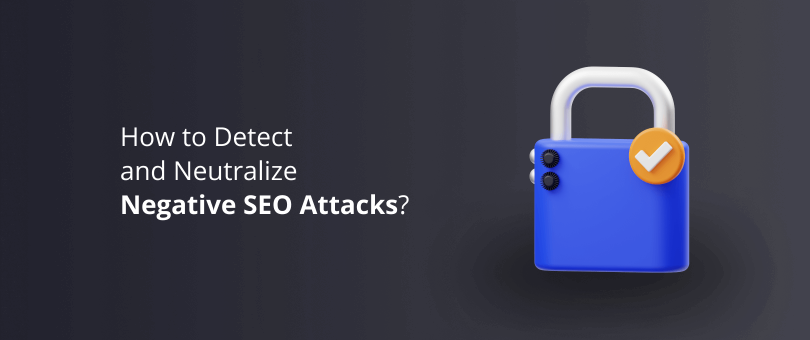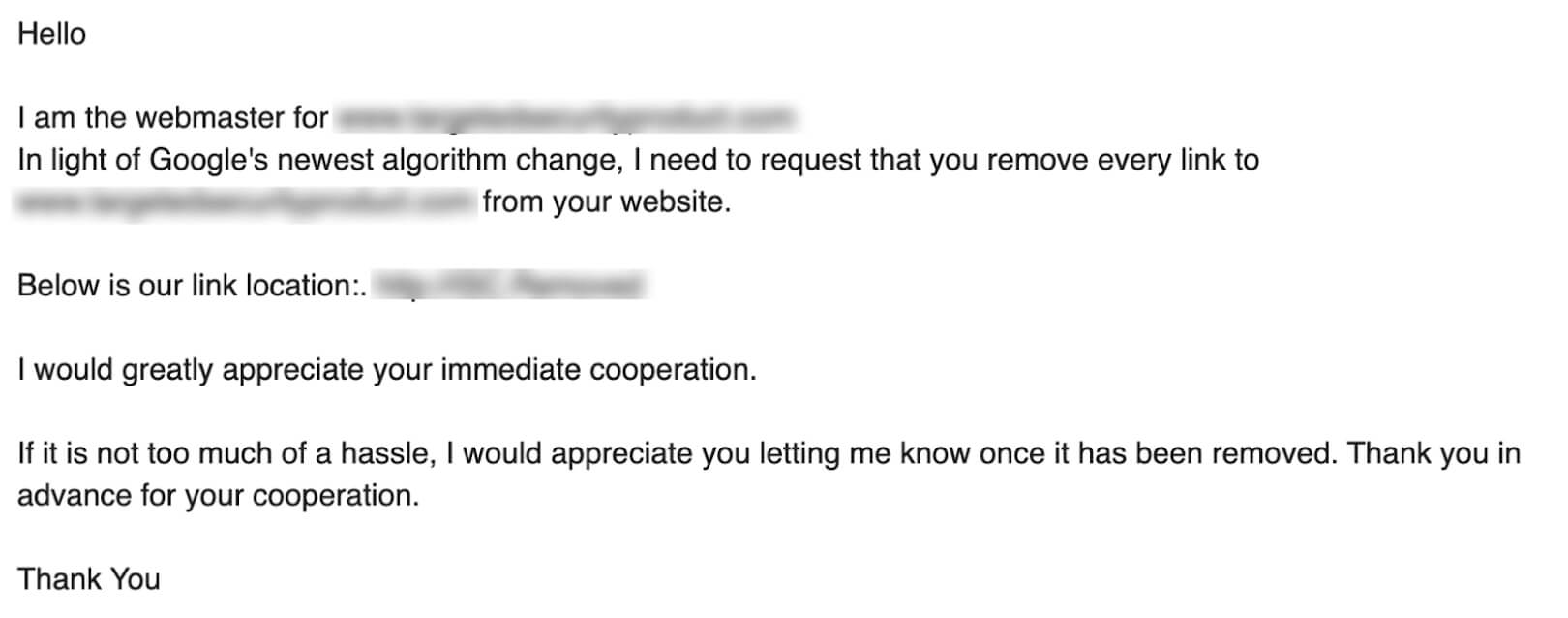Businesses can utilize white hat SEO approaches to optimize their websites for search engines. Yet, even if you follow these to the letter and obtain great results, you may occasionally see drastic fluctuations in your organic traffic. More often than not, these are the result of an algorithm update, and they either fix themselves in a few days or require you to make adjustments and comply with the new search engine standards.
However, if you have been diligent with your SEO practices, and there have been no recent Google updates, you may have fallen victim to a negative SEO attack.
Negative SEO is a malicious practice that a competitor may use in an attempt to sabotage your site’s rankings. It is an SEO tactic that is not only unethical but can sometimes even be illegal. Not to mention that a damaged search engine ranking can be quite difficult and time-consuming to clean up.
Unfortunately, as the web expands, negative SEO is now a regular occurrence, requiring businesses to be proactive in their efforts to prevent it. It’s important to monitor and regularly inspect your backlink profile, so you can prevent these attacks and save yourself from Google penalizing you for it.
In this blog post, we will cover all you need to know to detect, deflect, and fight off negative SEO. We will take a look at the different types of SEO attacks, how harmful they can be, and what you can do to protect your site.
5 Types of Negative SEO Attacks to Watch Out for

There are various types of negative SEO attacks that businesses can be exposed to. Here are the most common ones to be aware of.
1. Toxic Backlinks
A few toxic or spammy backlinks may not hurt your SEO, but when the number grows to hundreds or thousands you’re in trouble. To generate such a large amount of toxic links, the attacker will have likely used automated software, link farms, or public blog networks.
Most of these links will likely have the same exact-match anchor text and can be either completely unrelated to your site, or they could contain a niche keyword to make it seem as if you’re trying to manipulate your rankings.
For example, if you own a web development company, you could have those links targeting a more generic keyword like “tech team”, or you could have suspicious sites anchoring to an industry-specific term such as “agile project management.”
Whichever the case, if you don’t spot and remove these links in time, especially those targeting “agile project management”, the search engine algorithm may assume that you are trying to create a link scheme to manipulate your page ranking, and thus penalize you.
2. Scraped Content
This SEO practice involves creating copies of all or part of your pages’ content onto other sites to ruin your rankings. When Google comes across duplicate content on multiple sites, it will only rank one of those versions.
For the most part, the search engine algorithm is smart enough to differentiate the original copy from the fake ones. However, if it finds the scraped piece first or it is present on too many third-party locations, this can potentially create issues. The bots may become confused and the negative SEO attack may succeed.
3. Fake Negative Reviews
Generating malicious reviews is a negative SEO practice that can harm a business’s online reputation, and lead to significant issues, including, but not limited to, traffic and revenue drops. This is a growing SEO issue for many companies because it’s extremely easy for anyone to create an account and leave a negative review.
Not all bad reviews are a negative SEO attack, however, you must be diligent in tracking those types of reviews and managing them. While Google has set in place policies and restrictions to prevent this, its algorithm is not always quick enough to catch such violations.
4. Fake Backlinks Removal Requests
SEO attackers can be very sneaky and, in their effort to harm your site rankings, they may target your backlink profile in more than one way. One of which is filing fake backlinks removal requests.
If a competitor is trying to harm your site’s ranking, they can impersonate you or an agency acting on your behalf, and contact domain administrators requesting removal of some of your backlinks.
Such requests can look something like this:
5. A Hacked Website
An attacker who wants to create even more damage might go as far as hacking your website. If they manage to do that, amongst other things, they can damage your SEO efforts in whichever way can.
While this type of attack can lead to a myriad of other major issues, the negative SEO it can cause should not be underestimated. It can result in search engine visibility loss, content and backlinks disaster, and, in a nutshell, a full-on reputation crisis.
How to Remove Negative SEO?
It’s important to stress that before you start thinking about “How to remove negative SEO?” and jump to any conclusion that your site has been a victim of such an attack, first, you need to analyze your backlink profile.
Detecting and proving negative SEO attacks can be tricky. More often than not, any website’s backlinks are likely to contain some unmanaged toxic links to content that is not of the highest quality. However, this doesn’t necessarily mean that these are the result of a deliberate SEO attack from a third party.
Furthermore, as mentioned, website managers may not be taking into account factors that can cause a drop in traffic, such as algorithm updates and algorithmic filtering. Hence, it’s essential that you keep a close eye on your backlink profile and ensure that your site’s content is original, engaging, and optimized.
Related: Forget Black Hat SEO, Think White Hat SEO
How to Tackle Negative SEO?
If someone really wants to damage your website’s ranking, they can make multiple SEO attacks. Hence, to minimize the negative effects of such events, proaction is always better than reaction. Here are a few preventative tips to consider.

1. Maintain a Solid Backlink Profile
Backlinks are one of the top three most important ranking factors for Google, so you can’t afford to ignore them. A strong backlink strategy and an up-to-date backlink portfolio are essential to ensure that your website performs well.
Once you have those in place, it’s important to perform a backlink audit regularly. This involves:
- Reviewing your backlink score to detect any suspicious backlinks.
- Monitoring your website authority score and inspecting any changes in this trend.
- Creating and frequently updating your disavow file.
2. Regularly Monitor for Scrapped Content
Duplicate content can create cannibalization issues and result in completely filtering some web pages out of the SERPs. This negative SEO attack can really sabotage your site’s search performance so you need to be on your guard.
You can spot scraped content with the help of a dedicated tool or with Google Alerts. Once you identify troublesome pages, consider taking the following steps:
- Get in touch with the provider of the website that copied your content.
- Fill in this Google Form to report the issue and demand that the content be taken down.
- Report the attack through the FTC Complaint Assistant.
3. Report Fake Negative Reviews
Reviews can strongly affect a website’s ranking and local SEO, which is why negative and especially fake negative reviews can be very harmful. If you’re a large retailer you might not even notice the damage, but if you’re a small to medium-sized business you certainly will.
The growing list of negative reviews can tarnish a site’s reputation over time, thus causing its traffic to dwindle. However, it takes a lot of persistent work for a wrongdoer to achieve this, which affords you the opportunity to spot the negative SEO attack early on.
Be diligent, monitor your reviews regularly, and investigate every case. Trying to communicate the issue and provide a solution will not only allow you to improve customer service satisfaction but may reveal which reviews have been forged. Once you are certain that a review is fake, report it to the platform onto which it was published.
Related: 10 Essential Ways Professional SEO Can Give You Better Ranking
4. Fend Off Fake Backlinks Removal Requests
This type of negative SEO attack is a bit more tricky to spot, but not impossible. You might not be notified if and when someone is sending fake removal requests. However, if you use a backlink tool you can set up notifications for lost backlinks there.
The best thing you can do is to safeguard your backlinks as much as you can, especially the most valuable ones. Additionally, you can get in touch with your domain administrator and require them not to accept any backlink removal requests sent from any other emails than your own.
5. Detect Security Breaches
If your website is hacked by negative SEO, chances are that the attacker will not hijack your entire operation. Instead, they could stay low-key and perform malicious actions that are harder to notice, such as messing with your sitemap or robots.txt. These can hurt your SEO without you even realizing it.
To neutralize such threats, set up security breach alerts in your Google Search Console, then perform site audits on a regular basis.
Wrapping Up
Competitors using shady SEO techniques are a real problem that can be quite damaging. While some negative SEO attacks may have less severe aftermath than others, they are all threats that should not be taken lightly.
The best way to protect your site’s search engine ranking is to be proactive. This means sticking to good SEO practices and being on guard about changes to your backlinks and analytics profile.





